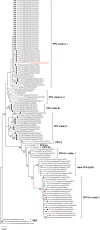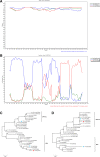Molecular characteristics and genetic evolutionary analyses of circulating parvoviruses derived from cats in Beijing
- PMID: 35606875
- PMCID: PMC9125828
- DOI: 10.1186/s12917-022-03281-w
Molecular characteristics and genetic evolutionary analyses of circulating parvoviruses derived from cats in Beijing
Abstract
Background: Feline parvovirus (FPV) is a member of the family Parvoviridae, which is a major enteric pathogen of cats worldwide. This study aimed to investigate the prevalence of feline parvovirus in Beijing of China and analyze the genetic features of detected viruses.
Results: In this study, a total of 60 (8.5%) parvovirus-positive samples were detected from 702 cat fecal samples using parvovirus-specific PCR. The complete VP2 genes were amplified from all these samples. Among them, 55 (91.7%) sequences were characterized as FPV, and the other five (8.3%) were typed as canine parvovirus type 2 (CPV-2) variants, comprised of four CPV-2c and a new CPV-2b strain. In order to investigate the origin of CPV-2 variants in cats, we amplified full-length VP2 genes from seven fecal samples of dogs infected with CPV-2, which were further classified as CPV-2c. The sequences of new CPV-2b/MT270586 and CPV-2c/MT270587 detected from feline samples shared 100% identity with previous canine isolates KT156833 and MF467242 respectively, suggesting the CPV-2 variants circulating in cats might be derived from dogs. Sequence analysis indicated new mutations, Ala91Ser and Ser192Phe, in the FPV sequences, while obtained CPV-2c carried mutations reported in Asian CPV variants, showing they share a common evolutionary pattern with the Asian 2c strains. Interestingly, the FPV sequence (MT270571), displaying four CPV-specific residues, was found to be a putative recombinant sequence between CPV-2c and FPV. Phylogenetic analysis of the VP2 gene showed that amino acid and nucleotide mutations promoted the evolution of FPV and CPV lineages.
Conclusions: Our findings will be helpful to further understand the circulation and evolution of feline and canine parvovirus in Beijing.
Keywords: Canine parvovirus (CPV); Evolution; Feline parvovirus (FPV); Recombination; VP2 gene.
© 2022. The Author(s).
Conflict of interest statement
The authors declare that they have no competing interests.
Figures


Similar articles
-
Prevalence and Molecular Evolution of Parvovirus in Cats in Eastern Shandong, China, between 2021 and 2022.Transbound Emerg Dis. 2024 Jan 5;2024:5514806. doi: 10.1155/2024/5514806. eCollection 2024. Transbound Emerg Dis. 2024. PMID: 40303163 Free PMC article.
-
Analysis of canine parvoviruses circulating in Australia reveals predominance of variant 2b and identifies feline parvovirus-like mutations in the capsid proteins.Transbound Emerg Dis. 2021 Mar;68(2):656-666. doi: 10.1111/tbed.13727. Epub 2020 Jul 29. Transbound Emerg Dis. 2021. PMID: 32657506
-
Molecular analysis of partial VP-2 gene amplified from rectal swab samples of diarrheic dogs in Pakistan confirms the circulation of canine parvovirus genetic variant CPV-2a and detects sequences of feline panleukopenia virus (FPV).Virol J. 2018 Mar 15;15(1):45. doi: 10.1186/s12985-018-0958-y. Virol J. 2018. PMID: 29544546 Free PMC article.
-
Surveillance activity for canine parvovirus in Italy.J Vet Med B Infect Dis Vet Public Health. 2005 Sep-Oct;52(7-8):312-5. doi: 10.1111/j.1439-0450.2005.00875.x. J Vet Med B Infect Dis Vet Public Health. 2005. PMID: 16316390 Review.
-
Host range relationships and the evolution of canine parvovirus.Vet Microbiol. 1999 Sep 1;69(1-2):29-40. doi: 10.1016/s0378-1135(99)00084-x. Vet Microbiol. 1999. PMID: 10515266 Review.
Cited by
-
Two novel sites determine genetic relationships between CPV-2 and FPV: an epidemiological survey of canine and feline parvoviruses in Changchun, China (2020).Front Vet Sci. 2024 Nov 4;11:1444984. doi: 10.3389/fvets.2024.1444984. eCollection 2024. Front Vet Sci. 2024. PMID: 39559542 Free PMC article.
-
Prevalence and Molecular Evolution of Parvovirus in Cats in Eastern Shandong, China, between 2021 and 2022.Transbound Emerg Dis. 2024 Jan 5;2024:5514806. doi: 10.1155/2024/5514806. eCollection 2024. Transbound Emerg Dis. 2024. PMID: 40303163 Free PMC article.
-
Molecular characterization and genetic diversity of parvoviruses prevalent in cats in Central and Eastern China from 2018 to 2022.Front Vet Sci. 2023 Jul 31;10:1218810. doi: 10.3389/fvets.2023.1218810. eCollection 2023. Front Vet Sci. 2023. PMID: 37601752 Free PMC article.
-
Molecular and Evolutionary Characteristics of Chicken Parvovirus (ChPV) Genomes Detected in Chickens with Runting-Stunting Syndrome.Viruses. 2024 Aug 30;16(9):1389. doi: 10.3390/v16091389. Viruses. 2024. PMID: 39339865 Free PMC article.
-
Molecular Characterization of Feline Parvovirus from Domestic Cats in Henan Province, China from 2020 to 2022.Vet Sci. 2024 Jun 30;11(7):292. doi: 10.3390/vetsci11070292. Vet Sci. 2024. PMID: 39057976 Free PMC article.
References
-
- Niu J, Yi S, Hu G, Guo Y, Zhang S, Dong H, Zhao Y, Wang K. Prevalence and molecular characterization of parvovirus in domestic kittens from Northeast China during 2016–2017. Jpn J Vet Res. 2018;66(3):145–155.
MeSH terms
LinkOut - more resources
Full Text Sources
Miscellaneous

